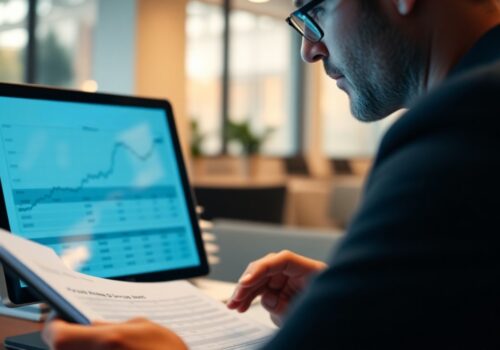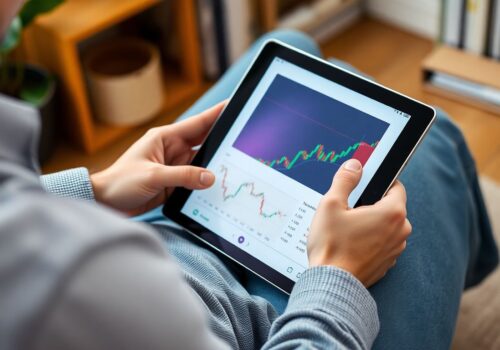How Lucrative are Trading Robots?
In an era dominated by technology, the financial realm has witnessed a revolutionary shift, thanks largely to automated trading. The once complex world of trading has been made more accessible and efficient through the use of trading robots. As the name suggests, these are not the robots of sci-fi movies but software programs designed to execute trades based on predefined algorithms and conditions.
A byproduct of algorithmic trading, these robots have carved out a significant niche in various financial markets, and their influence has only grown with the rise of digital currencies. Platforms like Expert Advisors on MetaTrader or other quantitative finance tools have allowed both novice and professional traders to harness the power of automation. It’s crucial to understand that behind these robots lie complex mathematical models and strategies, aiming to capitalize on market inefficiencies and trends.
Their evolution has mirrored the transformation of the trading landscape itself. From traditional stock markets to the bustling world of cryptocurrencies, trading robots are becoming an integral tool in a trader’s arsenal, promising not just convenience but also enhanced profitability.
As we delve deeper into this topic, let’s unravel the mysteries of these robots, their potential rewards, and the risks they entail. Prepare for an illuminating journey into the heart of modern trading!
Historical Context of Trading Automation
The history of trading is a testament to human ingenuity and adaptability, evolving continuously to match the pace of technological advances. While trading dates back millennia, the introduction of automation in this realm is relatively recent, yet profoundly impactful.
The initial phase of automation in trading took root in the stock markets. The 1970s marked a significant transition as the NYSE began to adopt electronic trading systems, a stark departure from the conventional outcry system. The goal? Speed, accuracy, and efficiency. These electronic systems paved the way for the first algorithms to emerge, designed to execute trades at rates impossible for human traders.
By the late 1980s and 1990s, the Forex Market, with its 24-hour trading cycle, recognized the immense potential of automation. Platforms like MetaTrader emerged in the early 2000s, offering traders an environment to develop, test, and deploy trading algorithms, known popularly as Expert Advisors.
The progression didn’t stop there. As the new millennium dawned, the fusion of technology and finance birthed cryptocurrencies, a revolutionary asset class. With this, the demand for sophisticated trading tools skyrocketed. Algorithms, which once predominated traditional markets, soon found their niche in the volatile world of crypto.
In essence, trading automation has metamorphosed from a mere concept in traditional markets to an indispensable tool in today’s digital trading realm. Its journey encapsulates a blend of technological marvel and financial evolution, mapping out the future trajectory of global trading.
Understanding the Basics of Trading Robots
At the heart of modern trading lies a powerful tool: the trading robot. But what exactly is it? Far removed from metallic androids and humanoid figures, trading robots are sophisticated software programs designed to make trading decisions on behalf of the user.
Central to these robots are algorithms. In essence, an algorithm is a set of instructions. For trading robots, these instructions dictate when to buy, sell, or hold an asset based on certain trading parameters. These parameters are derived from technical analysis, a method traders use to predict future price movements by studying past market data.
A cornerstone of technical analysis is indicators. These are statistical measures calculated from price history and volume, such as Moving Averages or Relative Strength Index. Trading robots utilize these indicators to inform their decision-making processes. For instance, a simple robot might be programmed to buy a cryptocurrency when its price is above a 50-day moving average and sell when below.
To ensure the effectiveness of their strategies, developers employ backtesting. This involves running the robot’s algorithm on historical data to see how it would have performed. If a strategy proves profitable in hindsight, it might be deemed worthy of real-time deployment.
Yet, the market is unpredictable. To guard against potential losses, robots are equipped with features like stop-loss and take-profit. A stop-loss order triggers a sale if the asset’s price drops to a certain level, minimizing losses. Conversely, a take-profit order does the opposite, selling the asset once it reaches a predetermined price to lock in profits.
In summary, trading robots are not magic profit machines but tools built on complex mathematical principles. Their efficacy relies on well-constructed algorithms, rigorous backtesting, and apt decision-making mechanisms that resonate with the market’s pulse.
The Pros of Using Trading Robots
The world of trading, especially within the crypto sphere, has become ever more dynamic and demanding. Amidst this hustle, trading robots have risen as champions, offering traders a host of advantages. Let’s delve into some of the most compelling benefits:
- Efficiency: Trading robots are renowned for their speed. They can process vast amounts of data, analyze market conditions, and execute trades faster than any human could. In markets where seconds can mean the difference between profit and loss, this speed is invaluable.
- Emotionless Trading: One of the most significant pitfalls in trading is human emotion. Fear and greed can lead traders to make irrational decisions, deviating from their strategies. Trading robots, devoid of emotions, stick rigorously to their algorithms, ensuring consistency in decision-making.
- 24/7 Trading: Cryptocurrencies never sleep. Unlike traditional markets with set opening and closing times, the crypto market operates round-the-clock. For a human, it’s impossible to monitor and trade continuously. Robots, on the other hand, can operate ceaselessly, ensuring no opportunity is missed.
- Backtesting: As previously discussed, backtesting allows traders to test their strategies on historical data. With trading robots, this process is streamlined. Traders can quickly tweak and optimize their strategies, gaining insights into potential profitability and risk.
- Mitigating Market Volatility: The crypto market is notorious for its volatility. Sharp price swings can occur within minutes. Trading robots, especially those designed for high-frequency trading, can capitalize on these swift movements, buying low and selling high in rapid succession.
- Objective Analysis: Trading robots rely on hard data and objective indicators. They’re devoid of biases, ensuring that trades are made based on facts and analysis rather than gut feelings or rumors.
In essence, trading robots present a blend of precision, efficiency, and consistency, making them invaluable assets in the fast-paced world of cryptocurrency trading. While they aren’t a guaranteed ticket to profits, their structured approach can offer traders a competitive edge in the market.
The Cons of Using Trading Robots
While trading robots have ushered in a new era of efficiency and precision, they are not without their shortcomings. Just as they can amplify profits, they can also accentuate losses if not used judiciously. Let’s explore some of the challenges and pitfalls associated with them:
- Over-reliance: The convenience of automation can lull traders into complacency, leading them to neglect necessary manual oversight. While robots operate on algorithms, they lack the intuitive judgment humans possess. Over-relying on them can sometimes mean missed cues or overlooked opportunities.
- Software Glitches: No software is entirely immune to bugs or glitches. A minor coding error can lead a robot to execute unintended trades. Such mishaps can result in significant losses, as seen in various flash crashes where algorithmic trading systems malfunctioned, causing sharp market downturns.
- Market Anomalies: Trading robots are designed based on historical data. However, the market is dynamic, influenced by myriad factors like geopolitical events or regulatory changes. Robots might falter when faced with unexpected market events, executing trades that aren’t optimal for the given situation.
- Cost Implications: Quality trading robots, especially those tailored for specific strategies, can be costly. Subscription fees, updates, and maintenance can add up, eating into potential profits.
- Latency Issues: Especially in high-frequency trading, a slight delay in data transmission can make a significant difference. Connectivity or server issues can impair a robot’s effectiveness, leading to sub-optimal trade execution.
- Limited Flexibility: Most trading robots operate within predefined parameters. In a rapidly changing market, a strategy that worked yesterday might not be as effective today. Unless regularly updated and optimized, robots can become outdated.
A poignant example is the 2010 “Flash Crash” where the U.S. stock market witnessed a rapid decline and recovery within minutes. Algorithmic trading, coupled with a lack of liquidity, exacerbated the crash, demonstrating the potential risks of over-reliance on automation.
In conclusion, while trading robots offer myriad advantages, they should be used as tools complementing human judgment rather than replacements. Traders must remain vigilant, ensuring they maintain a balanced approach to automation.
Profitability Factors to Consider
The allure of trading robots lies in the promise of profitability with reduced human effort. However, the equation isn’t as simple as setting up a robot and watching the profits roll in. Numerous factors, both inherent to the robot and external, play a pivotal role in determining its success rate. Let’s dissect these considerations:
- Initial Setup: The way a robot is initially set up has a profound impact on its future profitability. This includes selecting the right algorithm for the trader’s goals, risk tolerance, and market understanding. If this foundation is flawed, even the most advanced robot may not yield desirable ROI.
- Regular Maintenance: A trading robot isn’t a “set-it-and-forget-it” tool. Markets evolve, and strategies that were once lucrative might turn obsolete. It’s vital to review and tweak the robot’s settings, keeping it aligned with current market dynamics.
- Market Conditions: Robots, much like humans, perform differently under various market conditions. Some are optimized for a bull market, capitalizing on rising prices, while others might excel in a bear market, profiting from declining trends. A few might even be tailored for sideways markets, where prices move within a range. Identifying and deploying a robot best suited for the prevailing market condition is paramount.
- Robot’s Strategy: Not all robots are created equal. Some employ scalping strategies, targeting tiny price differences, while others might go for long-term trends. Understanding the underlying strategy is crucial as it determines the robot’s risk profile, potential profits, and suitability for a trader’s goals.
- Costs and Fees: Profits on paper might look appealing, but traders need to factor in the associated costs. This includes robot purchase or subscription fees, potential platform charges, and transaction costs. All these eat into the final returns.
- External Shocks: Events like regulatory changes, major geopolitical incidents, or macroeconomic factors can introduce sudden volatility. While robots analyze historical and real-time data, predicting such shocks often lies outside their purview. Traders should be prepared for such eventualities.
- Technology Infrastructure: The efficiency of a trading robot also depends on the robustness of the technological setup. High-speed internet connections, reliable power backups, and efficient hardware ensure the robot functions seamlessly, reducing chances of missed opportunities or losses due to glitches.
In essence, the profitability of trading robots doesn’t solely hinge on their algorithms. It’s a blend of the right setup, regular maintenance, and an environment conducive to the robot’s operation. Potential users must engage with these tools understanding their complexities, ensuring they are not just chasing profits but also mitigating potential risks.
Real-life Case Studies of Trading Robots
The cryptocurrency landscape has been a fertile ground for numerous trading robot experiments. These digital actors have both soared in triumph and faced tumultuous downturns. Let’s dive into some real-life instances that shed light on their performances.
- The Bitcoin Boom Success:
- Scenario: During Bitcoin’s meteoric rise in late 2017, certain trading robots, using momentum-based strategies, managed to capitalize immensely on this uptrend.
- Outcome: Traders using these robots reported substantial profits as the bots bought during minor dips and sold at higher peaks, riding the bullish wave.
- Lesson: Robots can be highly effective in strong trending markets, provided they’re set up with the right strategy.
- Ethereum Rally Misstep:
- Scenario: As Ethereum rallied in mid-2020, a specific trading robot, pegged to execute trades based on news sentiment, faced a glitch. It misinterpreted a piece of neutral news as negative.
- Outcome: The robot initiated a significant sell order, missing out on a subsequent price surge.
- Lesson: Over-reliance on a single data point, like news sentiment, can be risky. Diversifying strategies can offer more stability.
- Flash Crash on a Major Crypto Exchange:
- Scenario: A major crypto exchange experienced a flash crash in one of its trading pairs in 2019. Within minutes, the asset’s price plummeted and recovered.
- Outcome: High-frequency trading robots, which acted on the sudden price movement, either made huge profits by buying low or incurred substantial losses by selling assets erroneously.
- Lesson: Extreme market anomalies can be a double-edged sword for trading robots. Setting protective measures, like stop-losses, is vital.
In essence, trading robots, much like human traders, have had their days under the sun and moments in the shadows. Their efficacy is a blend of strategy, market dynamics, and, occasionally, a sprinkle of luck.
Conclusion
The journey through the realm of trading robots offers a kaleidoscope of opportunities and challenges. These digital tools, driven by algorithms, have transformed the landscape of trading, from traditional stock markets to the dynamic world of cryptocurrencies. However, as we’ve delved into their intricacies, a few truths stand out.
Firstly, while trading robots can significantly augment efficiency and profitability, they are not magical tools guaranteeing unerring success. The trader’s intuition remains invaluable. Even in an era dominated by automation, the human touch—the ability to feel the market pulse and adapt accordingly—retains its significance.
Secondly, the world of trading is in constant flux. With the rapid AI advancements, it’s plausible that future robots will be even more sophisticated, potentially blending algorithmic precision with a quasi-human ability to interpret market sentiments and nuances.
Yet, as we gaze into the future, the message for traders remains grounded: approach trading robots with a blend of caution and curiosity. Embrace their potential but also recognize their limitations. In the end, the most successful traders will likely be those who master the art of human-robot collaboration, leveraging the best of both worlds.
Embarking on this path, let’s carry forward a balanced perspective, understanding that in the dance of digits and dollars, both the tune and the steps matter.
FAQs
Are all trading robots profitable?
Certainly not. Trading robots can exhibit diverse results based on their underlying algorithms, optimization, and the market conditions they’re deployed in. Some robots might excel in trending markets while underperforming in sideways markets. Additionally, as markets evolve, a previously profitable robot may need adaptation and optimization to remain successful.
How do I choose the best trading robot for my needs?
Choosing the right trading robot involves meticulous due diligence. Start by clarifying your trading objectives and risk tolerance. Then:
- Research: Delve into the robot’s underlying strategy. Is it suitable for your goals?
- User Reviews: Online communities can offer insights into a robot’s performance and potential pitfalls.
- Backtest Results: A robot should ideally provide backtest results, showcasing its historical performance. However, remember that past performance doesn’t guarantee future results.
Can I use a trading robot without any trading knowledge?
While trading robots simplify the process, it’s imperative to have a basic understanding of trading principles. This knowledge aids in setting up the robot, understanding its operations, and managing risks. Moreover, even if you rely on a robot, ongoing learning about the market helps in making informed decisions, especially during unforeseen market events.
How often should I update or oversee my trading robot?
Trading robots aren’t a set-it-and-forget-it solution. Regular monitoring is essential. Factors to consider:
- Market Shifts: If the market undergoes significant changes (e.g., a bull run or a sudden crash), it might necessitate adjustments to your robot’s settings.
- Software Updates: Developers often release updates to refine the robot’s performance. Ensure your software is up-to-date.
- Performance Analysis: Periodically review the robot’s performance to detect any drifts from expected results.
Remember, while robots automate processes, the overarching responsibility for trading decisions remains with the user. Regular oversight ensures that you remain in control and can intervene when necessary.





